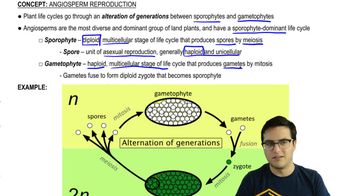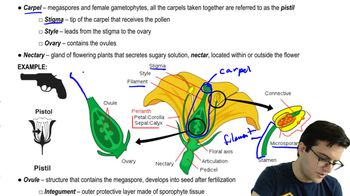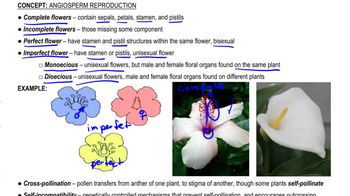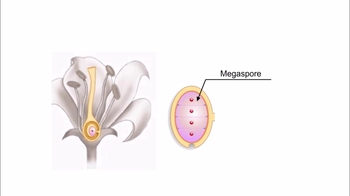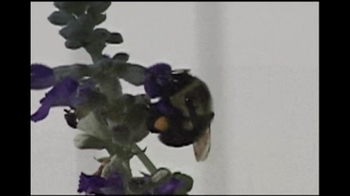[ Buzzing ] >> Cheeseburger all the way. If you snap your fingers and took away everything that honey bees contributed to, you'd be left with two buns, because the lettuce was grown from a plant that ultimately came from a seed that honey bees had to pollinate for seed production. The onions, the same. The tomatoes were pollinated by bumblebees to produce and set those tomatoes. The mustard came from plants that bees pollinated to set the seed. The beef, a lot of people would say, "We've got you on the beef," but the beef probably fed on clover or alfalfa at some point in its history. You got buns, that's what you've got, because the grain crops don't need pollinator contributions. So I've caught this bee, and you can see on her back leg there, we would call that a pollen ball, and it's packed into her pollen basket, or the fancy science name for it is corbicula. And then they use that pollen as their protein, vitamin, mineral nutrient source and they feed it to their immatures. So it takes pollen to produce bees. And in that process, plants are, of course, pollinated. We get our fruits, vegetables, nuts, and berries as a result. So because of the bees' efforts, some people estimate that as much as one-third of our food supply is dependent on honey bee pollination. So they pollinate things like blueberries and watermelons and cantaloupes and apples and squash and things like that. There are three types of bees in a colony. There's a queen whose only job is to produce offspring. She can lay up to 2,000 eggs per day. There are drones who are males, but drones are only produced during reproductive season when they're producing virgin queens who need drones with which to mate. Ninety-nine percent of the bees in the colony and certainly this time of year in winter are females and they're the worker bees. They're the ones who do all the work. They're the ones who feed the babies and forage for the food and build the comb and clean the colony and fight the invaders. Honey production occurs in the spring when most of the flowers are available. But in winter, in the absence of flowers from which to gather nectar and make honey, they have to have stored honey from spring and early summer to survive the coming winter. So if I take my hive tool and remove a little bit of this waxy capping, you'll see that there's honey stored underneath that capping. They're going to have this comb repaired by the end of the day and it won't even look like I've done what I just did. But honey bees don't function as individual bees. The individual really isn't important in the overall scheme. In fact, it's the colony and social insects that is considered the beast. They all have to be together to move this nest forward. There's actually a term for this. In entomology it's called super organism. The vast majority of the honey bees in the United States a tied up in commercial operations, and those commercial beekeepers use their bees to pollinate crops, and in return, we get not only more fruits, vegetables, and nuts and berries, but we get better quality fruits, vegetables, nuts, and berries. When bees are collecting pollen from a flower, something happens to that flower. When bees move pollen from the anther, the male parts, to the stigma, the female parts, that pollen grain that lands on that stigma grows what we call a pollen tube all the way down to the ovary of that flower, and the pollen, then releases its genetic material down that pollen tube which fertilizes the seeds. Once the seeds and a flower are fertilized, it fleshes out the fruit. If we didn't have bees pollination would be a nightmare. In Asia, for example, where pesticide use is very common, you know, hardcore pesticides that are being broadcast everywhere, and you have a reduction of bees and pollinators, they actually pollinate things like apples and pears with feathers. So it is possible to hand pollinate, but imagine doing that over an almond orchard; thousands upon thousands of acres with trees that are massive, full of hundreds of thousands of blooms, it's just not feasible. We need bees. Somewhere around the late 1930s, early 1940s, we peaked at about six million honey bee colonies. We have two and a half million today. So during that time, we have clearly had a decline problem. Everybody's talking about with much hysteria and paranoia what's going on today to our bees, but we have had a problem for 70 years, or maybe longer. 2006 is when this elevated levels of colony losses came out and people were frantically trying to figure out what it was. So they assigned this term "colony collapse disorder," is a disorder where the bees in a colony were just completely disappear. There's plenty of brood in the nest, so a lot of baby bees and the combs developing, but there are no adult bees to take care of them. And furthermore, there are no dead bees outside the colony. They're just vanished. Colony collapse disorder, this new phenomenon, is actually responsible for a small fraction of the overall losses in our honey bees. Bees die. Colonies die. These colonies here get varroa mites which is a parasite that gets on the outside of the bee's body and sucks their blood. The bees get viral diseases, bacterial diseases, fungal diseases. They get beetles that go into the nest. There are management stresses. They can be put in an environment where there's no nectar or not good enough quality pollen. So CCD, this colony collapse disorder, makes up a piece of this overall colony loss paradigm that we have happening in our colonies in the United States today. In the worst-case scenario, if bees continue to decline at the rates that we've seen, we're going to start to see agriculture affected. It's going to force people to think about pollination in a new way. We might lose the availability or the quality of these things that we've enjoyed for so long in our diet. But in ten years, I really feel that we'll have healthier honey bees; in 20 years, I think we'll have healthier agriculture pollination systems. And there's a massive grassroots movement in our research lab and research labs around the country in looking at this integrated crop pollination, and that includes everything from pesticide management on farms to planting schemes. Maybe you don't plant a 5,000-acre block of almonds. You plant ten acres of almonds and a strip of wildflowers, and ten acres of almonds and maybe you provide nesting habitat for bees. Maybe you're using honey bees and bumblebees and leaf-cutting bees to pollinate. This integration of farmer practices and pollinator practices that collectively produce same result: Lots of food. I hope that you can appreciate that even though bees do sting and can cause those kinds of problems, they are massively important for humans, really for ecosystem health in general. [ Buzzing ]
Table of contents
- 1. Introduction to Biology2h 40m
- 2. Chemistry3h 40m
- 3. Water1h 26m
- 4. Biomolecules2h 23m
- 5. Cell Components2h 26m
- 6. The Membrane2h 31m
- 7. Energy and Metabolism2h 0m
- 8. Respiration2h 40m
- 9. Photosynthesis2h 49m
- 10. Cell Signaling59m
- 11. Cell Division2h 47m
- 12. Meiosis2h 0m
- 13. Mendelian Genetics4h 41m
- Introduction to Mendel's Experiments7m
- Genotype vs. Phenotype17m
- Punnett Squares13m
- Mendel's Experiments26m
- Mendel's Laws18m
- Monohybrid Crosses16m
- Test Crosses14m
- Dihybrid Crosses20m
- Punnett Square Probability26m
- Incomplete Dominance vs. Codominance20m
- Epistasis7m
- Non-Mendelian Genetics12m
- Pedigrees6m
- Autosomal Inheritance21m
- Sex-Linked Inheritance43m
- X-Inactivation9m
- 14. DNA Synthesis2h 27m
- 15. Gene Expression3h 20m
- 16. Regulation of Expression3h 31m
- Introduction to Regulation of Gene Expression13m
- Prokaryotic Gene Regulation via Operons27m
- The Lac Operon21m
- Glucose's Impact on Lac Operon25m
- The Trp Operon20m
- Review of the Lac Operon & Trp Operon11m
- Introduction to Eukaryotic Gene Regulation9m
- Eukaryotic Chromatin Modifications16m
- Eukaryotic Transcriptional Control22m
- Eukaryotic Post-Transcriptional Regulation28m
- Eukaryotic Post-Translational Regulation13m
- 17. Viruses37m
- 18. Biotechnology2h 58m
- 19. Genomics17m
- 20. Development1h 5m
- 21. Evolution3h 1m
- 22. Evolution of Populations3h 52m
- 23. Speciation1h 37m
- 24. History of Life on Earth2h 6m
- 25. Phylogeny2h 31m
- 26. Prokaryotes4h 59m
- 27. Protists1h 12m
- 28. Plants1h 22m
- 29. Fungi36m
- 30. Overview of Animals34m
- 31. Invertebrates1h 2m
- 32. Vertebrates50m
- 33. Plant Anatomy1h 3m
- 34. Vascular Plant Transport2m
- 35. Soil37m
- 36. Plant Reproduction47m
- 37. Plant Sensation and Response1h 9m
- 38. Animal Form and Function1h 19m
- 39. Digestive System10m
- 40. Circulatory System1h 57m
- 41. Immune System1h 12m
- 42. Osmoregulation and Excretion50m
- 43. Endocrine System4m
- 44. Animal Reproduction2m
- 45. Nervous System55m
- 46. Sensory Systems46m
- 47. Muscle Systems23m
- 48. Ecology3h 11m
- Introduction to Ecology20m
- Biogeography14m
- Earth's Climate Patterns50m
- Introduction to Terrestrial Biomes10m
- Terrestrial Biomes: Near Equator13m
- Terrestrial Biomes: Temperate Regions10m
- Terrestrial Biomes: Northern Regions15m
- Introduction to Aquatic Biomes27m
- Freshwater Aquatic Biomes14m
- Marine Aquatic Biomes13m
- 49. Animal Behavior28m
- 50. Population Ecology3h 41m
- Introduction to Population Ecology28m
- Population Sampling Methods23m
- Life History12m
- Population Demography17m
- Factors Limiting Population Growth14m
- Introduction to Population Growth Models22m
- Linear Population Growth6m
- Exponential Population Growth29m
- Logistic Population Growth32m
- r/K Selection10m
- The Human Population22m
- 51. Community Ecology2h 46m
- Introduction to Community Ecology2m
- Introduction to Community Interactions9m
- Community Interactions: Competition (-/-)38m
- Community Interactions: Exploitation (+/-)23m
- Community Interactions: Mutualism (+/+) & Commensalism (+/0)9m
- Community Structure35m
- Community Dynamics26m
- Geographic Impact on Communities21m
- 52. Ecosystems2h 36m
- 53. Conservation Biology24m
36. Plant Reproduction
Flowers
Video duration:
6mPlay a video:
Related Videos
Related Practice

